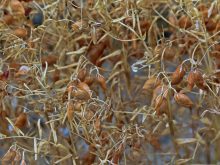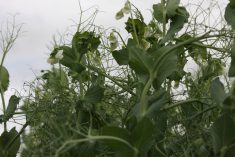The Case IH Trident 5550 applicator equipped with Raven Autonomy could be available for sale as soon as next year
The first spreader to come with factory-fit, autonomous operations was unveiled at the Farm Progress Show in Boone, Iowa.
Farms could receive deliveries of the Case IH Trident 5550 applicator equipped with Raven Autonomy as soon as next year.
“The release is perhaps the end of 2023. So, at this stage it’s unveiled to invite partners who want to collaborate with us on getting it further developed,” said Ben Voss of Raven Industries.
“We want to have lots of customer interaction and lots of customer involvement in the product development.”
He said there will be some limitations on the number machines available next summer, but that producers interested in trying the platform should contact the company.
The Case IH Trident 5550 applicator will use technology developed in the Omnipower (formerly DOT) and Omnidrive (formerly AutoCart).
The autonomous applicator is a significant milestone for the autonomy team at Case IH, which is under pressure to field autonomous equipment from competing equipment manufacturers including John Deere, which revealed a fully autonomous 8R tractor in January.
Operators can plan and initiate filed activity of the autonomous Trident 5550 applicator from a mobile device, or they can control, supervise and monitor its operations from another cab equipped with Raven technology.
“The main building blocks of the technology are actually a lot of core Raven technology that’s available largely in sprayers, but also in tractors and various implement applications,” Voss said.
“We have our steering guidance solutions. All precision farming equipment today is steered with satellite GPS and a display in the cab and a steering controller. That’s the same whether you put it in a sprayer, tractor or in Omnipower or in the Trident.”
The Trident 5550 applicator uses Raven’s Slingshot system, which is a suite of services that syncs the farm operations from field to office.
Slingshot offers connectivity and logistics features that increase visibility across farm fleets, by providing a range of real-time information sharing, monitoring, and reporting analytics to users’ computers, tablets, or cellphones.
“It gives you wireless connectivity to monitoring machines in real time, and to transmit data back and forth, including giving instructions and receiving back what it’s doing,” Voss said.
“Then you have all the tasks that you’re doing. So, with the Trident we have a spreader and a sprayer on that machine. Most of our work has been done with spreaders. On a spreader you have rate control, variable rate application, precision application. You’re sending prescription maps, you’re receiving back as applied information.”
Many of the machine functions, including braking, are controlled through the ECU that is installed in the Raven kit that makes the machine autonomous.
The Trident platform has only been on the market for a few years, and Voss said he’s optimistic Raven’s autonomy kit will be available as a retrofit for machines already covering acres.
There are numerous safety features that enable safe operations of the Trident 5550 applicator when in autonomous mode.
There are camera and radar sensors used to detect obstacles and provide feedback as to where the machine can and can’t drive.
The Omnidrive tech stack was especially important here as it was designed to control the operations of a tractor pulling a grain cart near a moving combine.
Safety features include a horn that will blow so people know it’s about to start driving, and a sensor that prevents people from riding along on the ladder.
However, Voss said the key safety features come down to the machine’s ability to perceive obstacles and dangers, and to prevent the machine from running in areas where it’s not supposed to.

“We’ve got geofencing and we’ve got safety fences on the machine itself, like basically breaker wires that if it touches something it stops. We also have the remote panic button that allows any human to basically hit that red button and everything stops,” Voss said.
“When you start adding it all up, it’s a whole lot more than you have on a regular tractor when Grandpa falls asleep when he’s driving.”
A significant drawback for autonomous machines that don’t have an operator’s station is the hassle of transporting them between fields, but this won’t hold the Trident 5550 back.
Having an operations station in a machine with an autonomous mode also provides the ability to use the system to help train and monitor inexperienced operators.
Even experienced operators that like to keep a close eye on their applications will find their days will become much easier by using autonomous technology.
For instance, Raven has a product called VSN, which is basically a camera that goes on a sprayer that helps keep the sprayer aligned with the crop rows.
Raven conducted a study where blood pressure and stress test measurements of operators were taken while they were running for extended hours.
“There’s a clear reduction in human stress by having a camera take over the steering. White-knuckle driving 12 hours a day is exhausting,” Voss said.
“They were feeling better, sleeping better, they were able to work longer hours and do more acres just because of that stretch reduction. So, I think that even if autonomy provides that to farmers, that’s huge.”
















